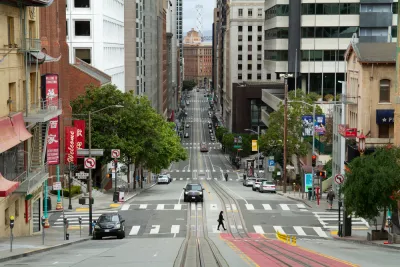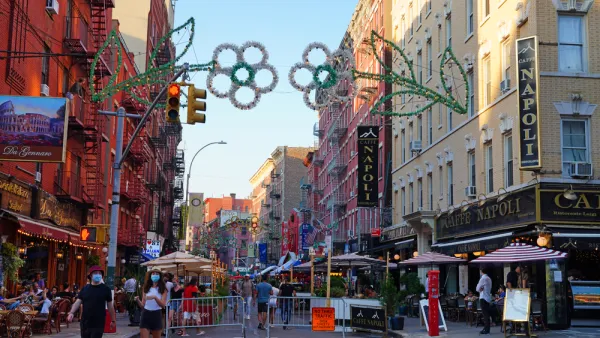“Downtown on the Brink” reads the headline of a recent San Francisco Chronicle feature.

Some Downtown San Francisco storefronts are still shuttered and graffitied, but some signs of life are returning to the streets as professionals and tourists return to the city’s famous urban neighborhoods. But the city’s Downtown is far from back to normal, and big changes will be necessary to avoid a “general economic decline,” according to a big interactive feature published recently by the San Francisco Chronicle, written by Noah Arroyo with visual supplements by Jessica Christian.
“Before the pandemic, office work was responsible for a whopping 72% of the city’s gross domestic product, according to the Controller’s Office — work that was heavily concentrated in the Financial District, the Market Street corridor, the Embarcadero and Mission Bay,” writes Arroyo.
Various metrics indicate Downtown San Francisco is far from recovered from the effects of working from home and social distancing. Office Space vacancy is up from 4.8 million square feet in the first quarter of 2019 to 18.7 million square feet in the first quarter of 2022, according to data presented in the article. That’s the highest level of office vacancies since the Great Recession. Convention attendees have dropped from 221,500 to 30,300 in the same period, and BART exits are down from 9.8 million to 2.3 million. Sales tax revenue in 2021 dropped to 33.5 million, compared to 55.6 million in 2019.
More data is included in the source article, with discussion of these trends focused on the effect for the city’s coffers, local businesses that operate in downtown neighborhoods, and public safety. The article also, however, asks “city planners, businesses and residents” what they will do in response.
“City officials and business leaders are working together, understanding that unless the city can defy national remote-work trends, its economic core will be forever altered,” writes Arroyo. So far, the San Francisco Office of Economic and Workforce Development is working on a strategy to bring the city’s economic core “back to life,” according to the article, but so far, city officials are taking a wait-and-see approach.
“It’s a bit premature for us to share specifics at this stage,” said Gloria Chan, the office’s director of communications, in an email to the Chronicle.
FULL STORY: Downtown S.F. on the brink: It’s worse than it looks

Analysis: Cybertruck Fatality Rate Far Exceeds That of Ford Pinto
The Tesla Cybertruck was recalled seven times last year.

National Parks Layoffs Will Cause Communities to Lose Billions
Thousands of essential park workers were laid off this week, just before the busy spring break season.

Retro-silient?: America’s First “Eco-burb,” The Woodlands Turns 50
A master-planned community north of Houston offers lessons on green infrastructure and resilient design, but falls short of its founder’s lofty affordability and walkability goals.

Test News Post 1
This is a summary

Analysis: Cybertruck Fatality Rate Far Exceeds That of Ford Pinto
The Tesla Cybertruck was recalled seven times last year.

Test News Headline 46
Test for the image on the front page.
Urban Design for Planners 1: Software Tools
This six-course series explores essential urban design concepts using open source software and equips planners with the tools they need to participate fully in the urban design process.
Planning for Universal Design
Learn the tools for implementing Universal Design in planning regulations.
EMC Planning Group, Inc.
Planetizen
Planetizen
Mpact (formerly Rail~Volution)
Great Falls Development Authority, Inc.
HUDs Office of Policy Development and Research
NYU Wagner Graduate School of Public Service



























